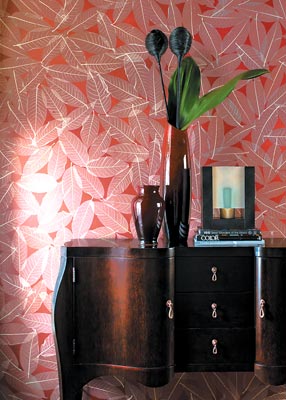If these walls could talk …
Sustainable is a popular word these days within the green world of the environment. All industries, be they manufacturers of milk cartons, automobiles, office furniture or even this newspaper you're reading, seem to be using it to describe how their products are made.
It's no different with wallcoverings, which are carefully monitored by various government agencies to ensure that the products' manufacture, installment and use are safe for the environment. Wallcoverings no longer use heavy metals (lead, mercury, chromium, cadmium) that could adversely affect the environment, and adhesives used in installation are environmentally sound, with many being water-based.
There is a wide selection of sustainable wallcoverings to choose from including old-fashioned, hand-made wallpapers and embossed wallpapers that can be painted.
Other wallcoverings are available in wood veneers from managed forests, alternative renewable papers (such as rice and parchment), fiber wallcoverings, cork wallcoverings that add insulating qualities, and fabrics that use significantly less dyes.
Tim Quinn, president of Chesapeake Wallcoverings (www.cheswall.com), said the eco-friendly attributes of nonwoven wallcoverings include that they be vinyl-free, breathable and be made with natural and synthetic fibers. This special blend of natural materials is what makes the wallpaper washable, breathable and easier to use on just about any walls including satin-, semigloss- and gloss-painted walls.
"Sustainable wallcoverings have arrived," said Quinn. "No more than two years ago, there was about a 7 percent saturation rate of this specific product in the world market. Last year it increased to 40 percent and it's tracking at 65 percent this year. We expect it to be 80 percent by the end of 2009. And it's all about performance. Homeowners can now change the décor of their homes as often as they want because the new wallcoverings, available at home retail outlets everywhere, are easy to install and even easier to remove."
At York Wallcoverings (www.yorkwall.com), LeRue Brown, director of marketing, said the renewable resource issue is one part of the current concern with environmentally friendly interior products.
"Although everyone seems to have their own idea about what green means, we view it from three different aspects," he explained. "First is the manufacturing process including energy usage and pollution. Then there's the renewability and sustainability of raw materials. Finally, we look at the indoor environmental impact of the product and its VOC emissions (volatile organic compounds), the chemical compounds that are measured for indoor air quality."
Brown said York, like other companies, uses water-based, low VOC inks and paper substrates to manufacture residential wallcoverings. The finished product then has a low VOC impact on the interior environment, much less than paint. In addition to paper products, other wallcoverings are made with natural, organic materials like grasses, leaves and wood laminate coverings that have proven to hold up over time.
"There is no compromise in quality and there are just as many designs and colors as ever," he explained. "We have done an audit of our paper suppliers and they are involved in forest management to renew and sustain their supply of pulp products and natural resources. Our main supplier has received certification for its reforestation program and we're pushing all of our suppliers toward a quantifiable program. Those not yet certified are renewing their supply of paper pulp products, but have not yet quantified their programs for certification."
All of this is bringing wallpaper, which is becoming quite popular and trendy among the young and fashion-forward types, to the forefront of home décor.
"Look in magazines like Vogue, Harper's Bazaar or Homes & Gardens and notice the background of the ads," said Quinn. "The model rooms have wallpaper. Interior designers are falling in love again with wallpaper and getting tired of paint. It's a bit of a Renaissance for wallpaper, yet something completely new for young homeowners."
And just in time. According to Quinn, the retail side of wallcoverings was a $4.4 billion dollar industry about 20 to 25 years ago; today, it is estimated at $650 million.
"That was then," he said. "Current research points to a return to wallpaper both in perception and performance, especially in the world market with cities in Europe and the Soviet Union leading the way. Income levels are rising and wallpaper is a status that signifies a nice home. Those ideas are now being felt here."

















